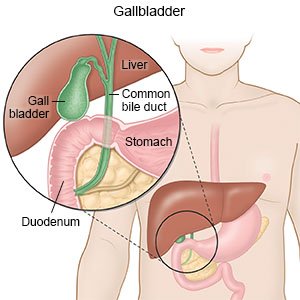Open Cholecystectomy
Medically reviewed by Drugs.com. Last updated on Apr 6, 2025.
An open cholecystectomy is surgery to remove your gallbladder through an incision in your abdomen.
 |
DISCHARGE INSTRUCTIONS:
Call your local emergency number (911 in the US) if:
- You feel lightheaded and have sudden shortness of breath.
- You have chest pain or cough up blood.
Seek care immediately if:
- Your vomit looks like coffee grounds, or has blood in it.
- Your abdomen is severely painful and swollen.
Call your doctor or surgeon if:
- Your arm or leg feels warm, tender, and painful. It may look swollen and red.
- You feel full and cannot burp or vomit.
- Blood soaks through your bandage.
- Your incision is red, swollen, or has pus coming from it.
- Your stitches come apart.
- Your vomit is green.
- You have a fever.
- You have nausea and are vomiting.
- You are constipated or urinate less than usual.
- You have questions or concerns about your condition, surgery, or care.
Drugs used to treat this and similar conditions
Tylenol
Tylenol is a pain reliever and a fever reducer used to treat many conditions such as headaches ...
Omvoh
Omvoh is used to treat moderate to severe ulcerative colitis or Crohn's disease in adults. This ...
Dilaudid
Dilaudid (hydromorphone) is a narcotic pain reliever used to treat moderate to severe pain ...
Paracetamol
Paracetamol (Panadol, Calpol, Alvedon) is a widely used over-the-counter painkiller and fever ...
Qutenza
Qutenza patches are used to treat neuropathic pain associated with postherpetic neuralgia and ...
Acetaminophen/hydrocodone
The combination of hydrocodone and acetaminophen is used to relieve moderate to severe pain ...
Hydrocodone
Hydrocodone (Hysingla ER and Zohydro ER) is used for around-the-clock treatment of severe pain ...
Medicines:
You may need any of the following:
- Prescription pain medicine may be given. Ask your healthcare provider how to take this medicine safely. Some prescription pain medicines contain acetaminophen. Do not take other medicines that contain acetaminophen without talking to your healthcare provider. Too much acetaminophen may cause liver damage. Prescription pain medicine may cause constipation. Ask your healthcare provider how to prevent or treat constipation.
- Antibiotics help prevent or fight an infection caused by bacteria.
- Take your medicine as directed. Contact your healthcare provider if you think your medicine is not helping or if you have side effects. Tell your provider if you are allergic to any medicine. Keep a list of the medicines, vitamins, and herbs you take. Include the amounts, and when and why you take them. Bring the list or the pill bottles to follow-up visits. Carry your medicine list with you in case of an emergency.
What to eat after surgery:
You may be given specific instructions for what to eat or not eat while you recover. The following are general guidelines:
- Eat low-fat foods for 4 to 6 weeks. This will help your body get used to digesting fat without a gallbladder. Slowly increase the amount of fat that you eat, as directed.
- Drink more liquids. Ask how much liquid to drink and which liquids are best for you.
Wound care:
- Keep the area clean and dry. Follow your provider's instructions on when you can bathe. Let water run gently over the area. Pat the area gently with a towel. Then put on a clean, new bandage as directed.
- Check for signs of infection. Look for redness, swelling, or pus each day. A fever is also a sign of infection.
Follow up with your doctor or surgeon as directed:
You may need to return to have your stitches removed. Your provider will check your incision for signs of infection. If you have a drain, he or she will remove it. Write down your questions so you remember to ask them during your visits.
© Copyright Merative 2025 Information is for End User's use only and may not be sold, redistributed or otherwise used for commercial purposes.
The above information is an educational aid only. It is not intended as medical advice for individual conditions or treatments. Talk to your doctor, nurse or pharmacist before following any medical regimen to see if it is safe and effective for you.
Further information
Always consult your healthcare provider to ensure the information displayed on this page applies to your personal circumstances.
